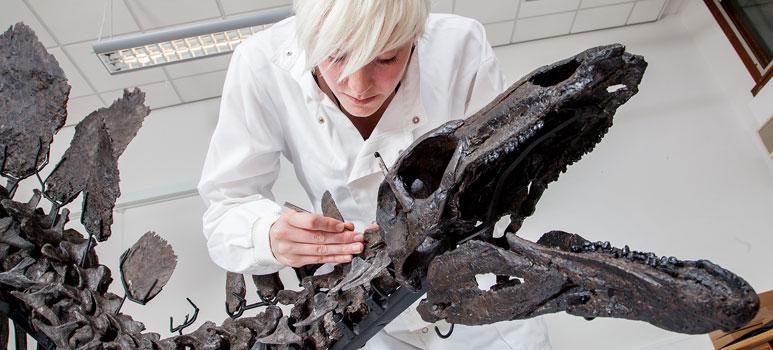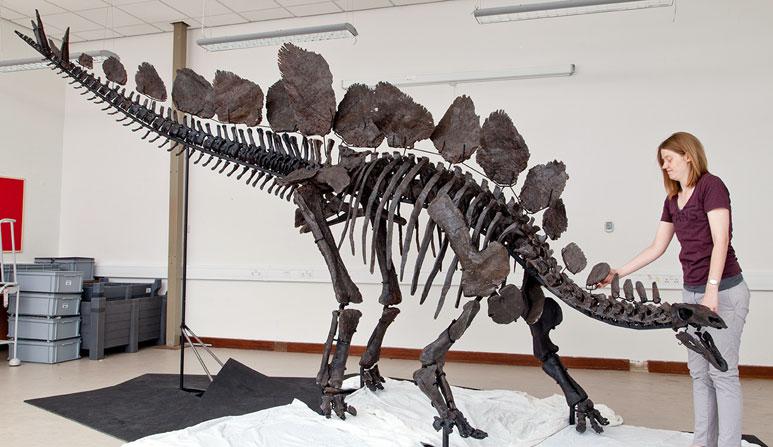 The Natural History Museum in London recently purchased one of the most well-preserved skeletons of a Stegosaurus known. It was discovered in 2005 in Wyoming, and using 3D scanning and printing, they plan to reveal the long-held secrets of these ancient beasts.
The Natural History Museum in London recently purchased one of the most well-preserved skeletons of a Stegosaurus known. It was discovered in 2005 in Wyoming, and using 3D scanning and printing, they plan to reveal the long-held secrets of these ancient beasts.
The skeleton, 18 feet long and 9 1/2 feet tall, was assembled in the Natural History Museum Earth Hall, and it’s a rare beast indeed.
“Stegosaurus fossil finds are rare,” said Professor Paul Barrett, the lead dinosaur researcher at the museum. “Having the world’s most complete example here for research means we can begin to uncover the secrets behind the evolution and behavior of this intriguing dinosaur species.”
And it was the rarity of ‘Sophie,’ as the Stegosaurus is known, that led the Natural History Museum to commission Propshop to laser-scan the Stegosaurus and create a 3D digital template of the find. The entire skeleton was scanned and specific pieces were 3D printed to preserve the form of the rare fossil in the event it’s ever lost or damaged.
 Dr. Charlotte Brassey says she used a technique called “convex hulling,” and she likens it to stretching a rubber sheet around the skeleton. She then analyzed the volume of the 3D shapes and found they correlated with the body mass of living examples of animals. Once she and Barrett took a set of very detailed measurements of the skeleton with the laser scans, CT scans, and 360° photography, they called in James Enright, the Managing Direct of Propshop for voxeljet UK, who says it was an honor for his firm to be asked to take on the project.
Dr. Charlotte Brassey says she used a technique called “convex hulling,” and she likens it to stretching a rubber sheet around the skeleton. She then analyzed the volume of the 3D shapes and found they correlated with the body mass of living examples of animals. Once she and Barrett took a set of very detailed measurements of the skeleton with the laser scans, CT scans, and 360° photography, they called in James Enright, the Managing Direct of Propshop for voxeljet UK, who says it was an honor for his firm to be asked to take on the project.
“We were able to use our experience in digitally scanning rare, large or one-off objects to good effect,” Enright says. “The skeleton was scanned using Lidar technology, and the data gathered from the noncontact, handheld, high-res Laser scanner was then digitally manipulated to create a highly accurate computerized model.”

Stegosaurus tail vertebra (A). Photogrammetry software created representation (B). 3D representation (C).
According to Enright, Propshop then used the data to 3D print some of the few missing parts of the skull, the radial plates, and tail bones with one of voxeljet’s larger printers. The parts were fabricated and finished using traditional modeling methods.
Propshop also created digital and real-world models which the museum plans to use to assess the strength and bone density of the skeleton. Museum staff also plan to use the models and data to fit the pieces and discover how they may have moved in the live version of a Stegosaurus.
“We’ve been using this mix of cutting edge technology and highly skilled craftsmanship for some time now, and it’s great to see it finding new applications and reaching new audiences,” Enright says. “The Natural History Museum is thrilled with the scan data, the modeling and the 3D printed touch objects. It’s incredibly forward looking, and I’m certain there will be further scope for future collaboration.”
Barrett was amazed to find such a remarkably complete dinosaur fossil, and he says the project is critical to discovering the many secrets of the Stegosaurus.
“Finding one as complete as this, where the only major parts missing are the left arm and base of the tail, is exceptional and it’s the only Stegosaurus in the world that’s anywhere near this complete,” Barrett said. “So it’s an amazing find and a really nice acquisition for the Museum.”
 According to Barrett, the first example of a Stegosaurus was discovered some 130 years ago, but he adds that even now, very little is known about its biology. He says that the fact that this new skeleton is nearly complete, and three-dimensional, means he and his research team can find out details such as how animal’s leg muscles worked or how the skull functioned during biting. He says the latter project involves taking a CT scan of the plate, turning it into a 3D model, and breaking the model down to thousands of ‘blocks’ which will then be compared to values from modern animal bones to extrapolate the overall strength of the skeleton’s bones.
According to Barrett, the first example of a Stegosaurus was discovered some 130 years ago, but he adds that even now, very little is known about its biology. He says that the fact that this new skeleton is nearly complete, and three-dimensional, means he and his research team can find out details such as how animal’s leg muscles worked or how the skull functioned during biting. He says the latter project involves taking a CT scan of the plate, turning it into a 3D model, and breaking the model down to thousands of ‘blocks’ which will then be compared to values from modern animal bones to extrapolate the overall strength of the skeleton’s bones.
Do you know of any projects like this where 3D scanning and printing are helping scientists understand the past? Let us know in the Sophie the Stegosaurus 3D Scanned forum thread on 3DPB.com.
Subscribe to Our Email Newsletter
Stay up-to-date on all the latest news from the 3D printing industry and receive information and offers from third party vendors.
Print Services
Upload your 3D Models and get them printed quickly and efficiently.
You May Also Like
3D Printing News Briefs, June 11, 2025: Sustainability, Automotive Tooling, & More
We’re starting with sustainability news in today’s 3D Printing News Briefs, as EOS has strengthened its commitment on climate responsibility, and Zestep is making 3D printing filament out of eyewear...
3D Printing 50 Polymer Stand-In Parts for Tokamaks at the PPPL & Elytt Energy
Of all the world’s things, a tokamak is one of the hardest, most complex, expensive and exacting ones to make. These fusion energy devices make plasma, and use magnets to...
3D Printing News Briefs, May 17, 2025: Color-Changing Materials, Humanoid Robot, & More
We’re covering research innovations in today’s 3D Printing News Briefs! First, Penn Engineering developed 3D printed materials that change color under stress, and UC Berkeley researchers created an open source,...
Firehawk Aerospace Partners with JuggerBot 3D, Gets $1.25M from AFWERX for 3D Printed Propellants
Texas-based Firehawk Aerospace, an advanced energetic materials firm that works with aerospace and defense applications, announced a strategic partnership with JuggerBot 3D, an Ohio-based large-format 3D printer manufacturer. Together, the...

































